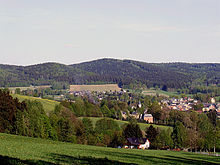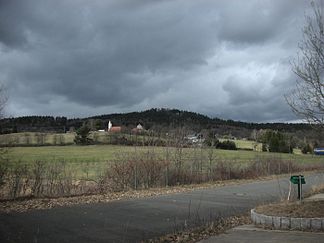Elster Mountains
| Elster Mountains | ||
|---|---|---|
|
The Elster Mountains on the Saxon-Czech border |
||
| Highest peak | Kapellenberg ( 759 m above sea level ) | |
| location | Saxony , Germany / Czech Republic border | |
| Cross-border part of the | Upper Vogtland , Western Ore Mountains , Fichtel Mountains | |
| Classification according to | Handbook of the natural structure of Germany / BfN | |
|
|
||
| Coordinates | 50 ° 11 ′ N , 12 ° 18 ′ E | |
|
View from the border crossing at Schönberg / Vojtanov ( D / CZ ; B 92 / S21) northwest to Schönberg and Kapellenberg |
||

The Elstergebirge ( Czech Halštrovské hory ), named after the river Weisse Elster , is a small mountain range in the Saxon Vogtland and in the Přirodní park Halštrov ( Elster Nature Park ) in the north-west of the Czech Republic .
In terms of nature , the mountains are located in the main unit Upper Vogtland (412) within the main unit group Vogtland (41).
geography
The Elster Mountains are located in the southernmost tip of Saxony in the German-Czech border area. It is delimited in the northeast by the Erlbach - Gunzen line from the Ore Mountains and in the southwest at Aš ( Asch ) and Hazlov ( Haslau ) from the Fichtel Mountains . The Rehau Forest joins to the west and the Eger Basin to the south .
mountains
The highest elevations are the Kapellenberg at 759 m above sea level. NN on the German and the Háj ( Hainberg ) with 758 m nm on the Czech side.
geology
General
The Elstergebirge consists for the most part of a crystalline rock base from the Old Paleozoic . The emerging metamorphic rocks were deposited as sediments from the Cambrian to the Silurian . During the Variscan orogeny , these rocks were folded and their bases were set up steeply to the south. The Fichtelgebirge intruded granite in the southwest . The youngest old sediments sporadically occur in the northeast of the mountains (High Brand) Silurian silica and alum shale .
The main mass are Ordovician and Cambrian phyllites . In the Paleozoic Sea, sandbanks were formed in the Cambrian and Ordovician times, which were metamorphosed into quartzites and today stand out from the surrounding area as steep cliffs. The high stone is a typical representative of these hardened people. To the north of Bad Brambach , Cambrian mica schists emerge on a narrow strip, followed by paragneiss to the south , before this sequence is interrupted by the granite pluton.
Sporadically there are tertiary basalt breakthroughs in the entire mountains as well as in the Erz- and Fichtelgebirge and in the Egergraben , of which only the chimneys have been preserved in the Elstergebirge . In the Tertiary, the Elster Mountains were raised in the east like a clod, geomorphologically this demolition to the Egertal occurs particularly near Schönberg / Vojtanov . In the eastern part of the mountains, on the border with the Ore Mountains, the area is traversed by an extensive northwest-southeast oriented fault system . This crosses the Erzgebirge demolition and is partly still active. There, there are repeated vertical tensions that discharge in earthquakes ( swarm quakes ). The Elster Mountains, in which there are mineral-rich springs, are one of the most seismically active regions in Central Europe.
Residual volcanism
With the vertical shifting of clods of the Egergraben towards the Erz, Elster and Fichtel Mountains, intense volcanic activity occurred up to the Quaternary . This has not yet completely subsided ( Kammerbühl and Eisenbühl in the Egertal). As residual phenomena, there are numerous mineral springs , some of which are highly radioactive and containing CO 2 , which are mostly used for spa and tourist purposes. There are also repeated series of earthquakes, the so-called swarmquakes.
Natural allocation
- Nomenclature in Germany
In terms of nature , the Kern-Elstergebirge is the southeastern part of the Upper Vogtland . However, this ends in the northeast already west of Zwota and southwestern already northeast of Eger , not only beside the river itself. Thus, the Elstergebirge in the East, where his highest elevations are, shares in West Erzgebirge and the southwest at the Fichtelgebirge belonging Selb-Wunsiedler plateau .
The manual of the natural structure of Germany of the former Federal Institute for Regional Studies describes the Elster Mountains as part of the Upper Vogtland, but draws the above-mentioned limits in its maps, which are used by the Federal Agency for Nature Conservation , which defines a natural Elster Mountains , which in particular are the highest Elevations according to the usual demarcation ( Počátecký vrch , Hoher Brand and Vysoký kámen ) excludes, whereby the Kapellenberg would be the highest elevation. The only a few years old revised natural spatial structure of the Saxon Environment Ministry draws a similar southwest border of the Western Ore Mountains, which roughly follows the (right-angled) line Gunzen - Markneukirchen - Erlbach .
The northeast border of the Fichtelgebirge runs in the mapping of the Federal Institute for Regional Studies from immediately north of Františkovy Lázně to northwest via Hazlov and meets the German border immediately west of Aš .
- Nomenclature in the Czech Republic
In the geomorphological classification of the Czech Republic , the Elster Mountains are part of the unit called Smrčiny , which in turn is part of the Krušnohorská hornatina ( Ore Mountains Mountains ). The Czech Republic does not have its own natural spatial unit, the “ Halštrovské hory ” (Elster Mountains).
Geomorphological division of the Czech Republic with the main unit Smrčiny (marked in red)
Individual evidence
- ↑ Halštrov Nature Park - see marking (broken ocher line)
- ↑ Strictly speaking, the Elster Mountains within these limits have small parts of the Western Ore Mountains in the northeast and of the Selb- Wunsiedler plateau, which is part of the Fichtel Mountains, in the southwest , see natural spatial allocation .
- ↑ Ascher Ländchen
- ↑ Map services ( Memento of the original from December 19, 2012 in the Internet Archive ) Info: The archive link has been inserted automatically and has not yet been checked. Please check the original and archive link according to the instructions and then remove this notice. of the BfN - the limits of the main units are those of the Institute for Regional Studies, but can only be activated within Germany.
- ↑ Landscape profile medium-high layers of the Upper Vogtland ( memento of the original from September 16, 2011 in the Internet Archive ) Info: The archive link was inserted automatically and has not yet been checked. Please check the original and archive link according to the instructions and then remove this notice. of the BfN with a rough map
- ^ Emil Meynen and Josef Schmithüsen : Handbook of the natural spatial structure of Germany , delivery 6 - Federal Institute for Regional Studies, Remagen 1959, updated map 1: 1,000,000 with main units 1960
- ↑ Agentura ochrany přírody a krajiny ČR and EkoCentrum Brno (eds.): Plzeňsko a Karlovarsko - Edice Chráněná území ČR , Volume XI; ARTEDIT Praha, 2004; ISBN 80-86064-68-9 ; Pp. 26-27
literature
- Karl Mannsfeld , Ralf-Uwe Syrbe (Ed.): Natural spaces in Saxony , in: Research on German regional studies (Volume 257), German Academy for Regional Studies, self-published, Leipzig, 2008, ISBN 978-3-88143-078-4
- Günther Schönfelder : Supplement to map A6 Physiogeographical overview (natural spaces) in: Atlas for the history and regional studies of Saxony, Saxon Academy of Sciences in Leipzig and State Enterprise Geobasis Information and Surveying Saxony (Ed.), Leipzig and Dresden, 2008, ISBN 978-3- 89679-713-1
Web links
- Interactive map research of the natural areas and natural area potentials of the Free State of Saxony , outlines and names of the 28 macro, 205 meso and 1462 micro geochors in the Free State of Saxony as well as text information on the mesogeochores, accessed on June 23, 2012



